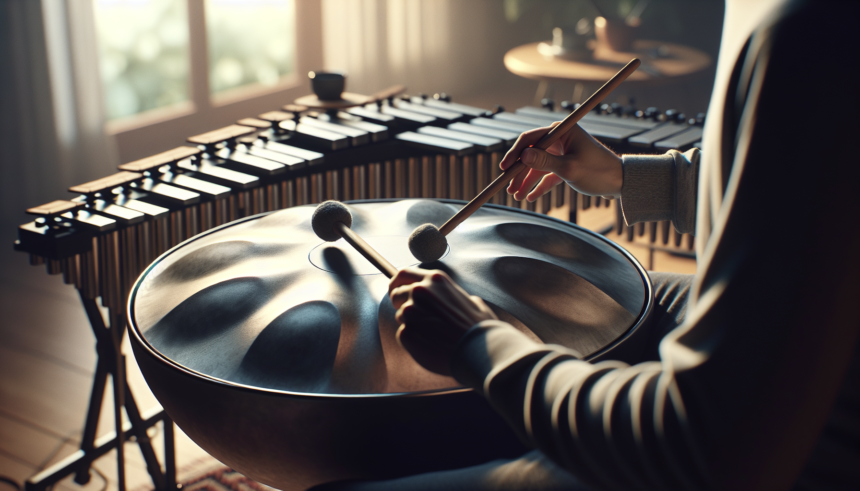The handpan is a captivating instrument known for its ethereal, meditative soundscapes. Traditionally played with the hands, it offers a wide range of tones and dynamics. However, using mallets on your handpan can unlock even more sonic possibilities and provide a refreshing twist on this magical instrument. In this article, we’ll explore the benefits of incorporating mallets into your handpan playing, discuss different types of mallets, and provide tips for getting the most out of this technique.
The Handpan: A Brief Overview
The handpan, often referred to as a hang drum, is a steel percussion instrument that produces a rich, resonant sound. It features a central note surrounded by a series of tone fields, each corresponding to a different note. Typically, the instrument is played with the hands, allowing for expressive control over dynamics and timbre.
Why Use Mallets?
While the handpan is commonly played with the hands, using mallets can introduce new dimensions to your playing. Here are some of the key benefits of this approach:
Expanded Sonic Palette
Mallets can produce a different timbre compared to hands. They offer a more percussive attack and can emphasize certain frequencies, creating a brighter, clearer sound. This can add variety to your playing and make your handpan performances more dynamic and engaging.
Increased Volume and Projection
Mallets can generate more volume than hands, making the handpan’s sound more prominent in ensemble settings or larger performance spaces. This allows the instrument to shine even in loud or crowded environments.
Enhanced Articulation and Precision
Using mallets can improve your control over the articulation and precision of each note. The hard surface of the mallet allows for cleaner, more defined strikes, which is particularly useful for fast or intricate passages.
Reduced Physical Strain
Playing the handpan with the hands for extended periods can be physically demanding. Mallets offer an alternative that can reduce strain on your hands and wrists, enabling longer practice or performance sessions without discomfort.
Types of Mallets
There are various types of mallets available, each offering unique characteristics. Here are some common options:
Felt Mallets
Felt mallets produce a warm, mellow tone and are gentle on the handpan’s surface. They are ideal for soft, subtle playing and can create a soothing, meditative atmosphere.
Rubber Mallets
Rubber mallets provide a balanced sound with a clear attack and moderate sustain. They are versatile and suitable for a wide range of playing styles, from delicate melodies to more rhythmic patterns.
Wooden Mallets
Wooden mallets offer a bright, resonant sound with a strong attack. They can bring out the handpan’s high frequencies and add a sharp, percussive element to your playing. However, they can be more challenging to control and may require a lighter touch.
Tips for Playing with Mallets
To get the most out of playing your handpan with mallets, consider the following tips:
Experiment with Different Mallets
Each type of mallet offers a distinct sound and feel. Experiment with different options to find the ones that best suit your playing style and musical preferences. You may even want to use multiple mallet types within a single performance to create contrast and variety.
Adjust Your Technique
Playing with mallets requires a slightly different technique than playing with your hands. Focus on maintaining a relaxed grip and using controlled, deliberate strikes. Pay attention to the angle and force of your strikes to achieve the desired sound without damaging the instrument.
Practice Dynamic Control
Mallets offer a wide range of dynamic possibilities, from soft, whispering notes to powerful, resonant strikes. Practice playing with varying levels of intensity to develop your dynamic control and add expressiveness to your performances.
Explore New Rhythms and Patterns
Mallets can open up new rhythmic possibilities that may be challenging to achieve with the hands alone. Experiment with different patterns, syncopations, and polyrhythms to expand your rhythmic vocabulary and create engaging, complex compositions.
Integrating Mallets into Your Practice Routine
Incorporating mallets into your practice routine can help you develop new skills and enhance your overall musicianship. Here are some suggestions for integrating mallets into your practice:
Warm-Up Exercises
Begin your practice sessions with warm-up exercises using both hands and mallets. Focus on basic techniques such as single strokes, double strokes, and rolls. This will help you build muscle memory and improve your control over both playing methods.
Technical Drills
Work on technical drills with mallets to develop your accuracy, speed, and articulation. Practice scales, arpeggios, and other technical patterns to improve your proficiency and confidence with the mallets.
Repertoire Practice
Incorporate mallets into your repertoire practice by playing familiar pieces with mallets instead of your hands. This will help you adapt to using mallets and provide a fresh perspective on your existing repertoire. Gradually introduce new pieces specifically for mallet playing to expand your repertoire further.
Conclusion
Using mallets on your handpan can be a game-changer, offering a wealth of new sounds and techniques to explore. By expanding your sonic palette, increasing volume and projection, enhancing articulation and precision, and reducing physical strain, mallets can take your handpan playing to new heights. With different types of mallets available and various techniques to master, the possibilities are endless. Embrace this exciting approach and discover the many benefits of switching it up with mallets on your handpan.
FAQs
1. Can using mallets damage my handpan?
As long as you use appropriate mallets (such as felt, rubber, or soft wooden mallets) and play with proper technique, using mallets should not damage your handpan. Avoid excessive force and always prioritize the health of your instrument.
2. Will using mallets change the tuning of my handpan?
Using mallets is unlikely to change the tuning of your handpan if you use them correctly. However, playing with extreme force or using very hard mallets could potentially affect the tuning over time. Always play with care and listen to your instrument.
3. Do I need special mallets for handpan playing?
While you can experiment with various percussion mallets, it is recommended to use mallets specifically designed for handpans to ensure the best sound quality and avoid damage. Handpan-specific mallets are typically designed with the instrument’s unique characteristics in mind.
4. How can I incorporate mallets into my existing handpan practice routine?
Start by adding mallet-specific exercises to your warm-up and technical drills. Gradually incorporate mallets into your repertoire practice, playing familiar pieces with mallets to adapt to the new technique. Over time, explore pieces specifically composed with mallets in mind.
5. Is it difficult to switch between playing with hands and mallets?
With practice, switching between hand and mallet playing can become seamless. Start by practicing short passages and transitions, gradually increasing the complexity as you become more comfortable. The key is to develop control and familiarity with both techniques.





